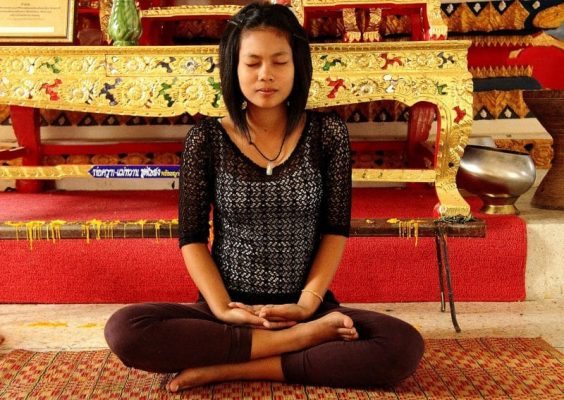I have been on this planet for a while – and in my recovery just about half as long. I have seen society go through a number of shifts regarding women, and I have seen women go through a number of shifts regarding themselves. The rooms of recovery have changed in response to both of these. From the early days when recovering women were seen as potential threats to their newly sober husbands, to the need to be warned against thirteen stepping for reasons of safety as well as sanity; the role of women in recovery has changed. From the back row to leadership roles women are embodying their strength and voice.
Yoga, once the exclusive practice of men has nearly reversed – where men are fewer in number in many studios. (Author’s note: Look, however, to leadership and status- the gender of those in that forum is out of proportion to practitioners, with men still in greater number than the representative factor of practitioners.) In studios and among teachers, there are more women than men.
That is the stage, the backdrop upon which women look to embrace their strengths, their health and their autonomy. In the rooms for recovery we learn to have our voice, in healthy meetings we are supported in finding our personal strength and autonomy. Women can also discover this on the yoga mat. With kindness and the practice of non-harming women can become comfortable with their physical strength and endurance. Women can investigate their flexibility and learn to monitor their self acceptance. In silence, investigating the fluctuations of the mind we can get to know ourselves a little better.
The hatha, or physical practice of yoga, has many benefits. The list is long, but as the full practice of all eight limbs of yoga embraces all areas of life, some of the key areas that a physical yoga practice can address are these;
Yoga is good for: bones and muscles
Yoga is good for: our endocrine and lymphatic systems
Yoga is good for: integration and integrity
Yoga is good for: developing, acknowledging and embracing strength and power
Yoga is good for: accepting yourself as you are
Yoga is good for: all life transitions, growing, prenatal, postnatal, aging and illness
Women have some unique health issues. The top two “killers” of women are heart disease and cancer. In addition to these extreme examples women also get cramps, bear and birth babies, women may nurse, they experience menopause and are more susceptible than men to diseases like stroke, heart attacks, and bone loss among others.
A regular mat based (asana) yoga practice can increase bone strength, maintain range of motion in the joints, and improve both flexibility and balance. These are terrific benefits for a lifetime of better health. Breath practices (pranayama) increase lung power, endurance, and release tension and stress. Meditation (dharana) has proven long term benefits in stress reduction as well as pain management. All together these yoga practices can prevent illness as well as manage the discomforts and pain associated with having them.
The movements of the poses, the transitions from pose to pose, and the rest between the poses contribute to healthy hormonal and endocrine systems. Some poses are designed specifically to stimulate certain glands to regulate hormones. All movement of joints and muscles help pump fluid through the lymph system in order to more efficiently remove waste from the body. Yoga does not need to be athletic, aerobic or acro in order to produce these benefits. One must only be mindful in the practice and approach it with integrative intention.
Yoga practiced with integrative intention fulfills the notion of yoking: the union of body mind and spirit. We in recovery suffer from a spiritual malady, a mental obsession and a physical allergy. Yoga can be a holisitic solution. In order for yoga to be able to fulfill the potential of being a holistic remedy, the suggestion is that we practice with intention for integration. Whether you are recovering from disordered eating, debt, substance or relationships misinterpretation of feelings is at the base. Misapprehension of the mind is at the root. Disconnection from one’s spiritual self is the result. Yoga integrates. It teaches you to feel what you are feeling, note what you are feeling, honor what you are feeling and, with compassion, let it pass. Both the good and the unpleasant; feel it and release it.
Yoga can build your strength. It is not a power activity, but over time with healthy alignment and sustained poses your core strength will improve, your capacity and endurance will grow. You can’t help it; if you work for it. This does not mean overdoing it. Let it take six months to gain six months of growth. Just as we can’t have the strength or serenity of someone who has ten years in recovery when we first enter the rooms; we have to work the program for ten years to get that. It is the same for yoga. You use your muscles but you can’t (without injury) muscle your way through. When you honor your own journey, accept yourself as you are, the miracle happens and you will find peace.
Women are often judged by their appearance. We judge ourselves by our appearance. Comparing ourselves to models, actors, ads, and others we most often find ourselves on the wrong side of the equation. Yoga is a perfect physical activity to practice “staying on your own mat.” In a yoga studio, practicing next others, you can come back to your own experience and your own challenges time and time again. It is this process of coming back to your mat and honoring your own feelings, accepting yourself as you are, that can give you strength in your recovery to be where you are, experience difficulty, with the knowledge that all will change.
Women also go through life phases. These are more dramatic than the physical phases men face. We all start out with our youthful bodies (men and women alike) and then, if we choose to, we swell with pregnancy. There are specific yoga practices (prenatal yoga) that are designed for expecting women. After giving birth we then adapt to a new body that has changed as the result of having had a child. Later our bodies begin to age and change with menopause. These stages each present with different challenges and limitations. All of these stages can affect a woman’s attitude toward herself. Not only does yoga help with the process of moving with and adjusting to the new body shape and abilities, but yoga can help maintain a suppleness and strength that helps us feel strong and capable even as the appearance of our body changes.
The long term practice of all the limbs of yoga; the restraints, the observances, the hatha (physical) yoga, the breathwork and sense withdrawal, the concentration, meditation and surrender- all of these contribute to a grounded person, an embodied person, a person with the power of choice, a person with the ability to love and accept herself. This is the practice of yoga, the practice of recovery and the practice of being whole.






